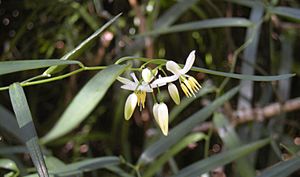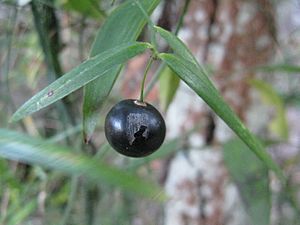Scrambling lily facts for kids
Quick facts for kids Scrambling lily |
|
|---|---|
 |
|
| Flowers, 26 Dec 2011 | |
 |
|
| Fruit, Feb 2011 at Paruna Reserve, Como, Sydney, NSW, by John Tann | |
| Scientific classification |
Geitonoplesium is a genus that contains only one type of plant: Geitonoplesium cymosum. This plant is commonly known as the scrambling lily. It belongs to the plant family called Asphodelaceae, which also includes plants like daylilies.
The scrambling lily grows naturally as a climbing plant, or vine. You can find it in different types of forests, like rainforests and drier woodlands. It grows in eastern Australia, the Philippines, Indonesia, New Guinea, Fiji, New Caledonia, Norfolk Island, and Lord Howe Island.
The leaves of the scrambling lily can look a bit different from plant to plant. They are usually long and narrow, like a spear or a line. They are typically about 2 to 10 centimeters (about 1 to 4 inches) long. The leaves are also about 3 to 25 millimeters (about 0.1 to 1 inch) wide. Both sides of the leaves are shiny. You can easily see the main vein sticking up on the top side of the leaf.
The flowers of the scrambling lily can be various shades of purple or white. After the flowers, the plant produces round fruits called berries. These berries are about 1 to 2 centimeters (about 0.4 to 0.8 inches) across. Inside the berries, you will find many small black seeds.
Uses of the Scrambling Lily
The young shoots of the scrambling lily can be picked and eaten. They taste a bit like asparagus or beans. People sometimes use them as a type of Bushfood. This plant is not very common in gardens or farms.
See also
 In Spanish: Geitonoplesium para niños
In Spanish: Geitonoplesium para niños

